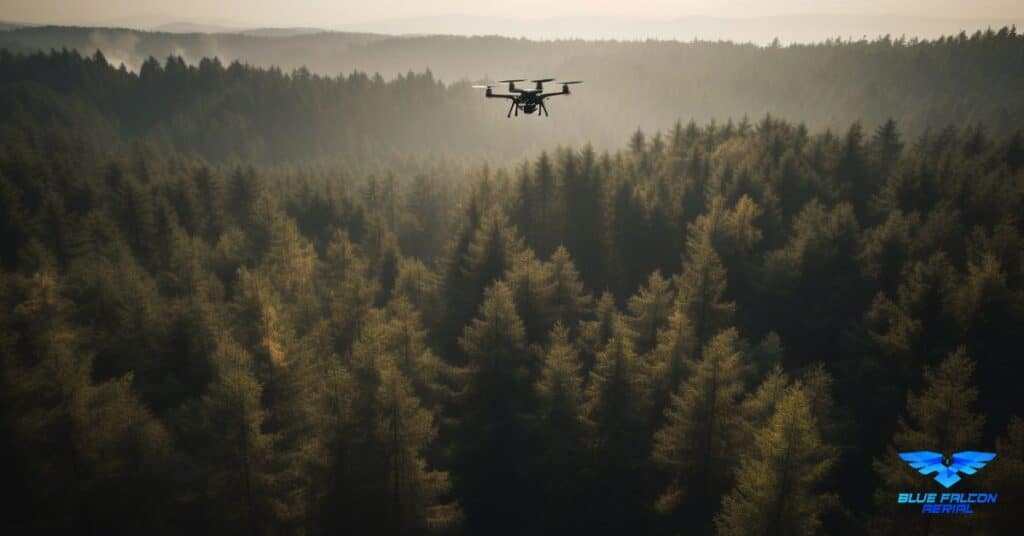Drones for Construction in Oklahoma are revolutionizing the way the industry operates, providing a plethora of benefits that save time, money, and enhance safety. As a local Oklahoma company, Blue Falcon Aerial understands the unique challenges faced by the state’s construction industry, making them an ideal partner for utilizing drone technology. In this article, we’ll explore five ways drones are benefiting Oklahoma’s construction industry, from improved site surveying to streamlined inspections.
Benefits of Using Drones in Construction Projects
Drones are increasingly becoming an essential tool in the construction industry, offering numerous advantages over traditional methods. Here, we explore some of the key benefits of using drones in construction projects.
Cost Savings
Drones help reduce costs by streamlining processes and increasing efficiency. They can quickly and accurately collect data, which helps construction companies make informed decisions and avoid costly errors. With faster data collection, project timelines can be shortened, reducing labor costs and minimizing downtime.
Time Efficiency
Drones can complete tasks such as surveying and monitoring in a fraction of the time it takes for traditional methods. They can quickly cover large areas, allowing project managers to access real-time data and make rapid decisions, resulting in faster project completion times.
Enhanced Accuracy
Equipped with advanced sensors and imaging technology, drones provide highly accurate and detailed data. This improved data quality enables better decision-making and more precise planning, reducing the risk of errors that can lead to costly rework.
Increased Worker Safety
Drones can access hard-to-reach or dangerous areas without putting workers at risk. By performing remote inspections and monitoring hazardous areas, drones help reduce workplace accidents and improve overall site safety.
Environmental Monitoring
Drones can monitor environmental conditions, track changes over time, and assess the impact of construction projects on the surrounding ecosystem. This helps companies comply with environmental regulations and protect the natural environment.
Regulations for Flying Drones in Oklahoma
Before using drones for construction projects in Oklahoma, it’s essential to be familiar with the Federal Aviation Administration (FAA) regulations and any local laws governing drone use. Here are some key guidelines to consider:
Drone Registration
Drones weighing between 0.55 lbs (250 grams) and 55 lbs (25 kg) must be registered with the FAA. Registration is required for both recreational and commercial drone use.
FAA Part 107 Certification
Commercial drone operators must hold a Remote Pilot Certificate, also known as Part 107 certification. To obtain this certification, operators must pass a knowledge test and meet age and security requirements.
Airspace Restrictions
Drones must be flown below 400 feet in uncontrolled airspace (Class G) unless given permission from air traffic control. They must avoid flying near airports, heliports, and other restricted areas. It’s essential to check for airspace restrictions using tools like the FAA’s B4UFLY app.
No-Fly Zones
Drone operators must respect no-fly zones, which include sensitive locations such as military installations, national parks, and critical infrastructure. Flying in these areas may require special permission from the relevant authorities.
Local Regulations
In addition to FAA regulations, drone operators must comply with any local laws governing drone use in Oklahoma. This may include restrictions on flying over private property, near public events, or in specific areas designated by the local government.
By adhering to these regulations, construction companies can safely and legally integrate drone technology into their projects, ensuring a smoother and more efficient construction process.
Drones in Site Surveys and Mapping
Drones have revolutionized site surveying and mapping in the construction industry, offering a more efficient, accurate, and cost-effective solution compared to traditional methods. In this section, we will discuss how drones can be used for site surveys and mapping in construction projects.
Best Drones for Construction Site Surveying
There are several drones on the market that excel in construction site surveying. Some of the best options include:
DJI Phantom 4 RTK: Known for its high-precision mapping capabilities and integrated RTK (Real-Time Kinematic) module, the DJI Phantom 4 RTK is ideal for construction site surveying. It provides accurate, high-resolution data that can be used for various applications, including topographic mapping and volumetric measurements.
SenseFly eBee X: The senseFly eBee X is a fixed-wing drone that boasts long flight times and the ability to cover large areas efficiently. With its range of payloads and advanced data processing capabilities, the eBee X is a versatile tool for construction site surveying.
Parrot Anafi USA: Designed with enterprise users in mind, the Parrot Anafi USA offers a rugged, reliable platform for construction site surveying. It features a high-resolution camera and thermal imaging capabilities, making it suitable for various surveying applications.
Drones for Aerial Mapping in Construction Projects
Drones offer several advantages when it comes to aerial mapping in construction projects:
Faster Data Collection: Drones can quickly survey large areas, capturing high-resolution images and data in a fraction of the time it takes for traditional methods.
High-Resolution Imagery: Drone-mounted cameras can capture detailed images with centimeter-level accuracy, allowing for precise measurements and analysis.
3D Modeling: Using photogrammetry software, drone-captured images can be transformed into detailed 3D models, providing valuable insights into terrain and site conditions.
Accessibility: Drones can easily access hard-to-reach or hazardous areas, ensuring comprehensive data collection.
Drones for Inspection and Monitoring of Construction Sites
Drones have become an invaluable tool for construction site inspections and monitoring, providing a safe, efficient, and cost-effective solution. In this section, we will discuss how drones can be used for inspection and monitoring of construction sites.
Drones for Construction Progress Monitoring
Drones can provide real-time progress updates on construction projects, offering several advantages:
Time-Lapse Photography: Drones can capture time-lapse images of the construction site, allowing project managers to track progress and identify potential issues.
Improved Communication: Drone-captured imagery can be shared with stakeholders, facilitating better communication and collaboration among project teams.
Resource Management: Real-time progress monitoring helps project managers allocate resources more effectively and make informed decisions about scheduling and staffing.
Drone Roof Inspection for Construction
Drone roof inspections offer a safer, more efficient alternative to traditional methods, providing detailed data on roof conditions without putting workers at risk. Key advantages include:
Safety: Drones can inspect roofs without the need for ladders or scaffolding, reducing the risk of falls and other accidents.
Speed: Drone inspections can be completed quickly, minimizing downtime and allowing construction to proceed on schedule.
Accuracy: High-resolution drone imagery can reveal damage, leaks, and other issues that may not be visible from the ground, allowing for targeted repairs and maintenance.
Affordable Drones for Construction Monitoring
While high-end drones offer advanced capabilities, there are also affordable options that can be effective for construction monitoring. Some budget-friendly options include:
- DJI Mini 2: The DJI Mini 2 is a compact, lightweight drone that offers excellent image quality and flight capabilities at an affordable price. It’s a great option for construction monitoring in smaller sites and urban environments, where portability and maneuverability are essential.
- Autel Robotics EVO Lite: The Autel Robotics EVO Lite is an affordable drone that features a 4K camera and a reliable flight platform. With its user-friendly interface and solid performance, the EVO Lite is a cost-effective choice for construction site monitoring.
- Parrot Anafi: The original Parrot Anafi is a versatile and affordable drone with a 4K camera and 180-degree tilting gimbal. Its compact design and reliable performance make it a suitable choice for smaller construction projects.
Benefits of Using Drones for Progress Tracking in Construction
Drones offer several benefits when it comes to progress tracking in construction projects:
Real-Time Updates: Drones provide real-time updates on construction progress, allowing project managers to make informed decisions and ensure projects stay on schedule.
Data Accessibility: Drone-captured data can be easily shared with project stakeholders, improving communication and collaboration.
Enhanced Documentation: Drones can generate detailed progress reports and visual documentation, which can be used to support claims, resolve disputes, and comply with regulatory requirements.
In summary, drones have become indispensable tools for inspection and monitoring in the construction industry, offering numerous advantages in terms of safety, efficiency, and cost savings. By integrating drone technology into construction projects, companies can streamline processes, improve communication, and enhance overall project outcomes.
Best Drones for Construction and Their Features
Selecting the right drone for construction applications is crucial to ensure efficiency and effectiveness. In this section, we will discuss some of the best drones for construction and their key features.
DJI Matrice 300 RTK
The DJI Matrice 300 RTK is a powerful, enterprise-grade drone designed for a wide range of professional applications, including construction. Key features include:
Long Flight Time: With a flight time of up to 55 minutes, the Matrice 300 RTK can cover large areas and complete complex tasks without frequent battery changes.
Multiple Payload Options: The drone supports various payloads, including high-resolution cameras, LIDAR sensors, and thermal imaging systems, allowing for versatile use in construction projects.
Advanced Safety Features: The Matrice 300 RTK includes obstacle avoidance, dual-battery redundancy, and an IP45-rated weather-resistant design, ensuring safe and reliable operation.
Autel Robotics EVO II Pro
The Autel Robotics EVO II Pro is a versatile drone suitable for a wide range of construction applications. Key features include:
6K Camera: The EVO II Pro boasts a high-resolution 6K camera, providing detailed imagery for accurate mapping and inspection tasks.
Extended Range: With a range of up to 5.5 miles, the EVO II Pro can cover large construction sites with ease.
Omni-directional Obstacle Avoidance: The drone features 12 computer vision sensors that provide 360-degree obstacle avoidance, ensuring safe operation in complex environments.
Yuneec H520
The Yuneec H520 is a hexacopter specifically designed for commercial applications, such as construction site inspections and monitoring. Key features include:
Modular Payloads: The H520 supports a range of interchangeable payloads, including high-resolution cameras and thermal imaging systems, offering versatility in construction projects.
Stable Flight: The hexacopter design provides stable flight, even in windy conditions, ensuring reliable data collection.
Retractable Landing Gear: The H520 features retractable landing gear, allowing for unobstructed 360-degree camera rotation and improved image capture.
Obtaining a Drone License in Oklahoma for Construction
Operating a drone for commercial purposes, such as construction, requires a Remote Pilot Certificate from the Federal Aviation Administration (FAA). In this section, we will discuss the process of obtaining a drone license in Oklahoma for construction projects.
Step 1: Meet Eligibility Requirements
To be eligible for the Remote Pilot Certificate, applicants must:
- Be at least 16 years old
- Be able to read, write, speak, and understand English
- Be in good physical and mental condition to safely operate a drone
Step 2: Prepare for the Knowledge Test
The FAA requires applicants to pass a knowledge test that covers topics such as airspace regulations, weather, and drone operations. Applicants can prepare for the test by studying the FAA’s study materials, attending a training course, or working with an experienced drone pilot.
Step 3: Schedule and Pass the Knowledge Test
The knowledge test, known as the Part 107 exam, can be taken at an FAA-approved testing center. Applicants must schedule the test in advance and pay a testing fee. To pass the exam, applicants must achieve a score of 70% or higher.
Step 4: Complete the FAA Application
After passing the knowledge test, applicants must complete the FAA’s online application for a Remote Pilot Certificate (FAA Form 8710-13). The application process includes a background check conducted by the Transportation Security Administration (TSA).
Step 5: Receive the Remote Pilot Certificate
Once the application is approved, applicants will receive their Remote Pilot Certificate, allowing them to legally operate drones for commercial purposes, such as construction projects, in Oklahoma. It is essential to maintain compliance with FAA regulations and local ordinances while operating drones for construction. The Remote Pilot Certificate must be renewed every two years by passing a recurrent knowledge test to ensure pilots stay up-to-date with current regulations and safety practices.
In conclusion, obtaining a drone license in Oklahoma for construction projects involves meeting eligibility requirements, preparing for and passing the Part 107 knowledge test, and completing the FAA application process. By obtaining the necessary certification, drone operators can ensure they are operating within legal guidelines and contributing to a safe and efficient construction industry.
Drone Technology in the Construction Industry
The construction industry is increasingly adopting drone technology to improve efficiency, safety, and cost-effectiveness. In this section, we will explore the various ways drone technology is being utilized in the construction industry.
Enhanced Communication and Collaboration
Drone-captured imagery and data can be easily shared with project stakeholders, improving communication and collaboration among team members. This increased transparency enables better decision-making, leading to more efficient and successful projects.
Improved Safety and Risk Management
Drones can access hard-to-reach and hazardous areas, reducing the need for workers to perform risky tasks. This reduces the likelihood of accidents, leading to a safer work environment. Additionally, drone-generated data can help identify potential risks and hazards, allowing for better risk management.
Accurate Data Collection and Analysis
Drones can capture high-resolution images and generate accurate data, such as 3D models, topographic maps, and volumetric measurements. This data is essential for project planning, design, and execution, ensuring a higher degree of accuracy and reducing the potential for costly errors.
Environmental Impact Assessments
Drones can be used to assess the environmental impact of construction projects, providing valuable data on factors such as vegetation, wildlife habitats, and water resources. This information is crucial for complying with environmental regulations and minimizing the project’s ecological footprint.
Drones for Construction Material Delivery
Drones are not only useful for surveying and inspection but can also be utilized for transporting construction materials. In this section, we will discuss the potential benefits of using drones for construction material delivery.
Reduced Labor and Equipment Costs
Using drones for material delivery can reduce the need for manual labor and heavy equipment, such as cranes and forklifts. This can lead to significant cost savings and a more efficient construction process.
Faster and More Efficient Delivery
Drones can transport materials quickly and efficiently, minimizing downtime and improving overall project timelines. They can also navigate challenging terrain and access hard-to-reach areas, enabling material delivery in situations where traditional methods may be impractical.
Lower Environmental Impact
Drones produce fewer emissions than traditional construction vehicles and equipment, reducing the environmental impact of construction projects. Additionally, by minimizing the need for heavy equipment on-site, drones can help reduce soil compaction and other environmental disruptions.
Potential Limitations and Challenges
While drones offer significant benefits for construction material delivery, there are some limitations and challenges to consider:
Weight and Size Limitations: Drones can currently only carry a limited amount of weight, making them more suitable for transporting small, lightweight items.
Regulatory Restrictions: Commercial drone operations are subject to FAA regulations, which may limit the potential applications for construction material delivery.
Public Perception and Privacy Concerns: The use of drones for material delivery may raise privacy concerns among nearby residents and businesses, as well as concerns about noise pollution and safety.
Despite these challenges, drones hold great potential for revolutionizing construction material delivery, offering improved efficiency, cost savings, and reduced environmental impact. As technology advances and regulations evolve, drones are likely to become an increasingly common sight on construction sites, further transforming the industry.
Drones for Construction Material Delivery
Drones are becoming increasingly popular for transporting construction materials, providing several advantages over traditional methods. In this section, we will explore the potential benefits and applications of using drones for construction material delivery.
Efficient and Cost-Effective
Using drones for material delivery can improve efficiency and reduce costs associated with labor and heavy equipment, such as cranes and forklifts. Drones can quickly transport materials, minimizing downtime and improving project timelines.
Access to Remote and Hard-to-Reach Areas
Drones can easily navigate challenging terrain and deliver materials to remote or hard-to-reach locations. This capability makes drones an ideal solution for construction projects in areas with limited access or where traditional delivery methods are impractical.
Reduced Environmental Impact
Drones produce fewer emissions than traditional construction vehicles and equipment, contributing to a lower environmental impact. Additionally, by minimizing the need for heavy equipment on-site, drones can help reduce soil compaction and other environmental disruptions.
Environmental Impact Assessments
Drones can play a vital role in conducting environmental impact assessments (EIAs) for construction projects. In this section, we will discuss how drones can be used to assess the environmental impact of construction projects and support compliance with environmental regulations.
Detailed and Accurate Data Collection
Drones can capture high-resolution images and generate accurate data, such as topographic maps, vegetation maps, and water resource maps. This information is crucial for understanding the potential environmental impacts of a construction project and developing effective mitigation strategies.
Rapid Assessment
Drones can cover large areas quickly, reducing the time and effort required for conducting EIAs. This increased efficiency enables project teams to make informed decisions and implement environmental best practices more rapidly.
Minimizing Disturbance to Wildlife
Drones can conduct EIAs with minimal disturbance to wildlife and their habitats, providing a non-invasive alternative to traditional assessment methods.
Wildlife Monitoring
Drones can be a valuable tool for wildlife monitoring during construction projects, helping to ensure that project activities do not negatively impact local species. In this section, we will discuss the potential applications of drones for wildlife monitoring in construction projects.
Nesting Bird Surveys
Drones equipped with high-resolution cameras can be used to conduct nesting bird surveys, identifying the presence of protected species and helping to ensure compliance with wildlife protection regulations.
Wildlife Corridor Assessments
Drones can be used to assess the potential impact of construction projects on wildlife corridors, helping to identify areas where mitigation measures, such as wildlife crossings or habitat restoration, may be needed.
Post-Construction Monitoring
Following the completion of a construction project, drones can be used to monitor wildlife populations and habitat conditions, ensuring that mitigation measures have been successful and identifying any potential issues that may require further action.
Erosion Control
Erosion control is a critical aspect of construction projects, helping to prevent sediment and pollutants from entering waterways and damaging ecosystems. In this section, we will discuss how drones can be used to support erosion control efforts on construction sites.
Identifying Erosion Risks
Drones can be used to identify areas of a construction site that may be at risk of erosion, such as steep slopes, exposed soils, or poorly-vegetated areas. By identifying these risks, project teams can take appropriate measures to prevent erosion and protect water resources.
Monitoring Erosion Control Measures
Drones can be used to monitor the effectiveness of erosion control measures, such as silt fences, sediment basins, or revegetation efforts. Regular drone-based monitoring can help to ensure that these measures are functioning correctly and identify any issues that may require maintenance or adjustments.
Rapid Response to Erosion Events
In the event of a significant erosion event, such as a landslide or severe storm, drones can be used to quickly assess the extent of the damage and identify areas that may require immediate intervention. This rapid response can help to minimize the environmental impacts of erosion events and support timely remediation efforts.
In conclusion, drones are revolutionizing the construction industry in Oklahoma by enhancing site safety, improving efficiency, reducing costs, and providing valuable environmental insights. Companies looking to harness the power of drone technology for orthomosaic and LiDAR projects should consider working with a local Oklahoma business, such as Blue Falcon Aerial.
Blue Falcon Aerial specializes in providing high-quality drone services, including construction site monitoring, mapping, and inspection. They offer a range of deliverables that can help construction companies unlock the full potential of drone technology, such as orthomosaic maps, digital elevation models, and 3D point clouds generated from LiDAR data.
By selecting the right drone for the job, obtaining the necessary certifications, and adhering to regulations, construction companies can enjoy the numerous benefits of drone technology. Don’t hesitate to contact Blue Falcon Aerial if you require any drone services for your construction projects in Oklahoma.




